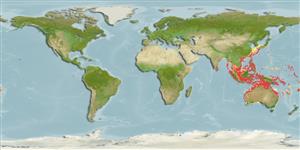Common names from other countries
Environment: milieu / climate zone / depth range / distribution range
Ekologi
; kisaran kedalaman 0 - 90 m (Ref. 81020). Tropical
Indo-West Pacific.
Length at first maturity / Size / Weight / umur
Maturity: Lm ? range ? - ? cm
Active during the day and at night, sits on hard corals or gorgonians (Ref. 800). On coral heads and pinnacles at a depth of less than 10 m; rubble and sediment bottom (Ref. 100368). Suspension feeder (Ref. 68823).
Life cycle and mating behavior
Kematangan | Reproduksi, perkembang biakan | Pemijahan | telur-telur | Fecundity | Larva
Members of the class Crinoidea are gonochoric. During spawning, the pinnule walls rupture and the eggs and sperms are shed into the seawater. Life cycle: Embryos elongate into free-swimming larvae (doliolaria) which later sink to the bottom where they metamorphose into stalked sessile crinoid.
rujukan utama
Acuan | Koordinator | mitra
Schoppe, S. 2000. (Ref. 800)
Status IUCN Red List (Ref. 130435)
status CITES (Ref. 108899)
Not Evaluated
Not Evaluated
ancaman kepada manusia
Harmless
penggunaan manusia
| FishSource |
Alat, peralatan
informasi lanjut
Umur / Saiz
Pertumbuhan
panjang-berat
panjang-panjang
Morfologi
Larva
Kelimpahan
Sumber internet
Estimates based on models
Preferred temperature
(Ref.
115969): 20.7 - 28.8, mean 27.3 (based on 656 cells).
kategori harga
Unknown.
